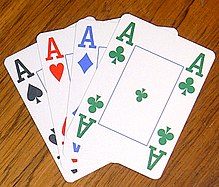Spades (suit): Difference between revisions
→Characteristics: black pairs with Clubs Tags: Mobile edit Mobile web edit |
→Characteristics: queen of spades has its own page Tags: Mobile edit Mobile web edit |
||
| Line 36: | Line 36: | ||
File:10 of spades - David Bellot.svg|[[Ten of spades|10]] |
File:10 of spades - David Bellot.svg|[[Ten of spades|10]] |
||
File:Jack of spades fr.svg|[[Jack (playing card)|Jack]] |
File:Jack of spades fr.svg|[[Jack (playing card)|Jack]] |
||
File:Queen of spades fr.svg|[[Queen |
File:Queen of spades fr.svg|[[Queen of spades|Queen]] |
||
File:King of spades fr.svg|[[King (playing card)|King]] |
File:King of spades fr.svg|[[King (playing card)|King]] |
||
</gallery> |
</gallery> |
||
Revision as of 19:20, 29 July 2024
| Spades | |
|---|---|
 | |
| Native name | Template:Lang-fr |
| Deck | French-suited playing cards |
Spades (![]() ) (Template:Lang-fr) is one of the four playing card suits in the standard French-suited playing cards. It has the same shape as the leaf symbol in German-suited playing cards but its appearance is more akin to that of an upside down black heart with a stalk at its base. It symbolises the pike or halberd, two medieval weapons, but is actually an adaptation of the German suit symbol of Leaves created when French suits were invented around 1480.[1]
) (Template:Lang-fr) is one of the four playing card suits in the standard French-suited playing cards. It has the same shape as the leaf symbol in German-suited playing cards but its appearance is more akin to that of an upside down black heart with a stalk at its base. It symbolises the pike or halberd, two medieval weapons, but is actually an adaptation of the German suit symbol of Leaves created when French suits were invented around 1480.[1]
In bridge, spades rank as the highest suit. In skat and similar games, it is the second-highest suit.
Name
The word "Spade" is probably derived from the Old Spanish spado meaning "sword" and suggests that Spanish suits were used in England before French suits.[2]
The French name for this suit, Pique ("pike"), meant, in the 14th century, a weapon formed by an iron spike placed at the end of a pike.[3] In German it is known as Pik. It corresponds to the suit of leaves ![]() (Laub, Grün, Schippen or, in Bavaria, Gras) in the German-suited playing cards. In Switzerland, the suit is known as Schuufle ('shovel') and in many German regions, e.g., the Rhineland, as Schüppe/Schippe ('shovel').
(Laub, Grün, Schippen or, in Bavaria, Gras) in the German-suited playing cards. In Switzerland, the suit is known as Schuufle ('shovel') and in many German regions, e.g., the Rhineland, as Schüppe/Schippe ('shovel').
Characteristics
The spade symbol is a very stylized spearhead shape, pointing upwards, the bottom widening into two arcs of a circle and sweeping towards the centre to then form a sort of foot.
Generally, spades are black so they can be used in some games as a pair with Clubs (suit), like Klondike (solitaire). They form one of the two major suits in bridge (with hearts). In the official skat tournament deck, spades are green, assuming the color of their German-deck equivalent.
The following gallery shows the spades in a standard 52-card deck of French-suited playing cards. Not shown is the Knight of Spades used in Tarot card games:
Four-colour packs

Four-color decks are sometimes used in tournaments or online.[4] In four-colour packs Spades may be:
- black
 in English bridge and poker packs and French and Swiss four-colour packs,[5]
in English bridge and poker packs and French and Swiss four-colour packs,[5] - green
 in German skat tournament packs[5] or
in German skat tournament packs[5] or - blue
 in some American poker decks
in some American poker decks
Coding
The symbol ♠ is already in the computer code set CP437 and therefore also part of Windows WGL4. In Unicode a black ♠ and a white ♤ spade are defined:
| Symbol | Unicode | Entity in HTML |
|---|---|---|
| ♠ | U+2660 BLACK SPADE SUIT | ♠ or ♠
|
| ♤ | U+2664 WHITE SPADE SUIT | ♤
|
See also
References
- ^ Dummett (1980), p. 22.
- ^ Parlett (2008), p. xiv.
- ^ "Pique". Centre national de ressources textuelles et lexicales.
- ^ Allan & Mackay 2007, p. 155.
- ^ a b Gallery 3 - Sizes, Shapes and Colours at a_pollett.tripod.com. Retrieved 4 Aug 2020.
Literature
- Allan, Elkan and Hannah Mackay (2007). The Poker Encyclopedia. London: Portico. ISBN 978-1906-03209-8
- Dummett, Sir Michael (1980). The Game of Tarot. Duckworth, London. ISBN 0 7156 1014 7
- Parlett, David (2008). The Penguin Book of Card Games. London, New York, Toronto: Penguin. ISBN 978-0-141-03787-5













